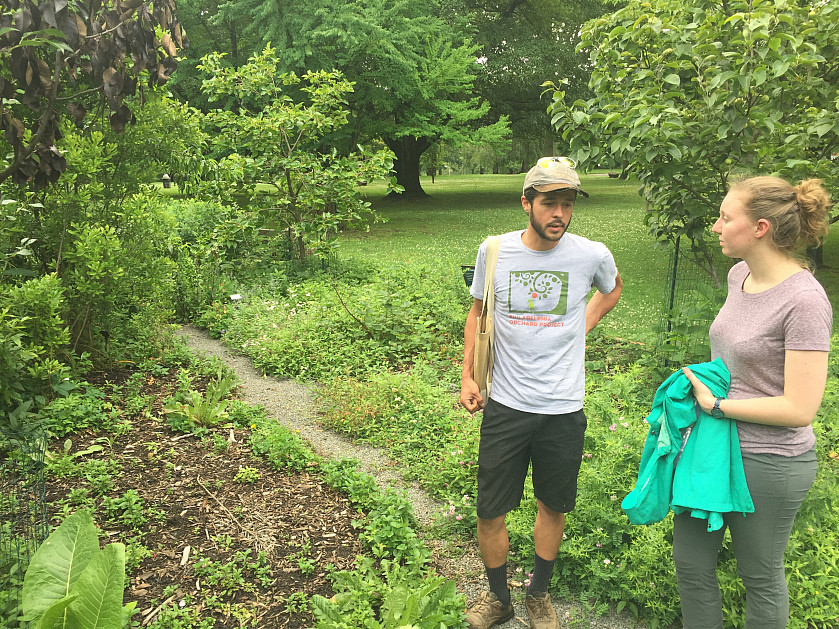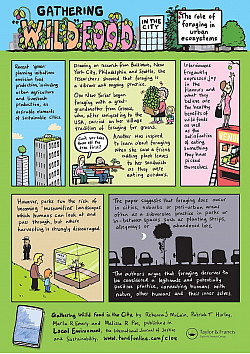
People and Urban Forests Research Group
Student researchers examine human-forest interactions in landscapes shaped by urbanization, whether these landscapes are characterized by urban, suburban, or exurban social-ecological dynamics.
The group’s research draws on human geography, forestry, and political ecology to enhance understandings of how diverse peoples’ everyday experiences with forested spaces influence patterns, use, and meanings of species in these places. Research findings are intended to improve our understandings of these urban forests and inform policy development and planning efforts that foster better sustainability outcomes.
Through their participation in the research group, students learn to employ surveys, in-depth interviews, aerial photography interpretation, document analysis, and GIS methodologies. These researchers and stewards frequently interact with researchers from the U.S. Forest Service and managers with local and regional non-profits. Our analyses focus on producing qualitatively rich and quantitatively grounded findings about the complex processes involved in human interactions with and benefits from urban forests. Although much of the research undertaken by the group occurs in southeastern Pennsylvania, research findings are intended to inform planning, policy, and scholarly discussions about forest management in diverse urban places and at a variety of scales.
Beginning in fall 2019, the group’s focus has grown to include an experiential and applied learning component at the food forest at the Whittaker Environmental Research Station. Through their stewardship, outreach, or data collection activities, students get hands-on experience with planting, pruning, and other strategies of care as well as with the diverse ecological dimensions of this multifunctional forest system. In doing so, students also live and help to document the ways in which these systems foster new understandings of forests and their species.
Bears in the Woods (BiW)
Much attention on urban forests is currently centered on the ecological benefits that trees and forested communities provide to urban residents. This includes ongoing efforts to value economically the ecosystem services, such as the stormwater or carbon sequestration benefits, these systems generate. Yet the emotional, spiritual, and other cultural values that people place on trees in the urban landscape have are increasingly overlooked as part of these assessments. Using the Ursinus campus, its tees, and the Ursinus community, this project examines the types and extent of attachments that members of the human community develop with our arboreal neighbors. This ongoing project is intended to contribute to scholarly understandings of the suburban forest, but also to inform College campus management through an eponymous online StoryMap.
Urban Forests and Foraging in the U.S. (UFF)
The productivity of urban forests and urban foraging have become important topics of discussion among scholars. Urban foraging and other types of harvests also have become popular among many living in U.S. cities, as well as a hot topic for discussion in the media. Drawing on surveys and in-depth interviews with foragers, the group’s analyses document: species and places that support foraging, how foragers incorporate harvested materials into their lives, and what this practice means for how we think about the values of trees in cities and suburbs. Findings suggest urban and suburban forests provide access to a wide range of foods, medicines, and other natural resources for use in residents’ daily lives. This includes trees, plants, and mushrooms found in diverse locations, from parks to residential yards.

- Hurley, P. and M. Emery. 2017. Locating provisioning ecosystem services in the city: An analysis of street trees in New York City. Landscape and Urban Planning http://dx.doi.org/10.1016/j.landurbplan.2017.09.025.
- Shackleton, C., P. Hurley, A. Dahlberg, M.R. Emery, and H. Nagendra. 2017. Urban foraging: Ubiquitous but overlooked by planners and policy. Sustainability 9, 1884, DOI: 10.3390/su9101884.
- Hurley, P., M. Emery, R. McLain, M. Poe, B. Grabbatin, and C. Goetcheus. 2015. Whose urban forest? The political ecology of foraging urban nontimber forest products. In Isenhour, C., G. McDonogh, and M. Checker (eds). Sustainability in the global city, myth and practice. Cambridge University Press: New York, NY.
- McLain, R., P. Hurley, M. Emery, and M. Poe. Gathering “wild” food in the city: rethinking the role of foraging in urban ecosystem planning and management. Local Environment 19(2): 220-240.
Food Forests in the Suburbs (FFiS)
Food forests are both old and new. Around the world, humans have often developed complex systems of mixed trees, shrubs, and other woody and non-woody plants to produce much needed food and fiber. Drawing on principles principles of urban agriculture, urban forestry, and agroforestry and permaculture, these more recently designed systems integrate multiple layers of woody and non-woody plants (tall trees, short trees, tall shrubs, short shrubs, and herbaceous plants), often based on native species found in local forest communities, to produce foods (berries, nuts, fruits, leaves, and blossoms, among others) and other materials for human consumption, while also seeking to enhance wildlife habitat, sequester carbon above and below the ground, support pollinators, enhance water quality, and support ecological leaning. By supporting these multiple functions, food forests represent an active form of sustainable land management. More importantly, applied stewardship and associated outreach activities provide new ways of learning about the benefits of these forests for human and nonhuman nature.
Forested “Islands” of Southeastern PA (FISPA)
Using grounded visualization techniques (Knigge and Cope 2006, Hurley et al. 2008), this research develops landscape ethnographies of forested ridgelines in southeastern Pennsylvania and are characterized primarily by species native to the Mid-Atlantic.Case studies of the Quakertown Swamp in Bucks County and Stone Hill in Montgomery County have been completed. Future case studies are planned for the Oley Hills in Berks County as well as the French Creek area of Berks County.
- McKinnon, I., P. Hurley, C. Hiner, M. Maccaroni, and T. Filian. 2017. “Uneven urban metabolisms: Toward an integrative (ex)urban political ecology of sustainability in and around the city.” Urban Geography
- Hurley, P., M. Maccaroni, and A. Williams. 2017. Resistant actors, resistant landscapes? A historical political ecology of a forested conservation object in exurban outheastern Pennsylvania. Landscape Research 42: 291-306.
- Hurley, P. and L. Taylor. 2016. From Swamp to Ridgeline: Exploring Exurbia in Southeastern Pennsylvania and the Sierra Nevada Foothills of California. In Taylor, L. and P. Hurley (eds). A Comparative Political Ecology of Exurbia. Springer Publishing: New York, NY.

Dr. Patrick Hurley leads the People and Urban Forest Research Group. Dr. Hurley is an environmental social scientist trained in interdisciplinary methods. His interest in forests began as a kid climbing trees, where he observed the urbanization of nearby landscapes, and has come to include forested ecosystems all over North America.